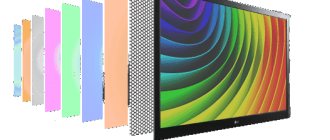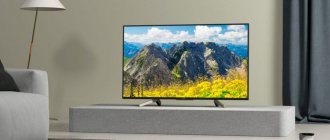When making the case for OLED TV, the first thing to note is that OLED TVs have become more popular over the past three years. But at the same time, numerous Internet forums around the world are not flooded with complaints about constant screen burn-in. The facts of image retention and test results were recently written on the ultrahd.su resource in an article about OLED burn-in.
At times there seems to be more talk about the rare procedures that TV producers put in place to counteract burnout than there are actual cases of real burnout. Perhaps the situation will change over time as significant experience with screen burn-in or non-burn-in is accumulated.
So far, the short time of use of OLED TV and the small number of people who may be affected by this problem are affecting. Therefore, we suggest you figure out whether it’s worth buying an OLED TV 2021 or not. It's also important to emphasize that the variety of typical TV usage patterns in the home naturally counteracts the constant occurrence of screen burn-in.
Most evidence so far suggests that only people who spend more than the average amount of time watching the same channel or playing games with static elements should be concerned about this. There is information about this in the article: OLED instructions on how to reduce the risk of burns.
What is OLED?
In 2013, LG began selling TVs with screens based on organic crystals. Now there are great hopes placed on this technology; scientists are working on creating not just flexible OLED screens, but transparent ultra-thin TVs that would broadcast high quality, as close as possible to the real world, without distortion.
OLED technology is based on organic light-emitting diodes, which emit light when electricity passes through them. Pixels light up one after another, which creates color fullness, richness, abundance of textures and excellent quality.
The scope of application of this development is devices created to display information, including televisions.
Types of OLED screens
There are several main varieties of this development, which have their own characteristics and areas of application.
AMOLED
A technology where the image is transmitted using small organic LEDs (organic matrix). In such a matrix, each pixel glows separately from the other, and when it is necessary to broadcast black, the diode is turned off, which allows you to achieve deep black.
Advantages:
- image richness – the picture will always be bright, rich and contrasting;
- high refresh rate.
Flaws:
- screen burnout, because diodes begin to work worse over time;
- unnatural shades - they can be too bright for everyone.
The scope of application of this technology is very clear: it is most often used in smartphones, digital cameras and televisions.
PHOLED
The technology works as follows: current is supplied to particles that produce light. Other types of OLED convert approximately 30% of the energy into light, while PHOLED can convert up to 100%.
Due to this, their scope of application is wide: use in lighting, which should be uniform and bright. These can be wall monitors, windows and large TVs.
Peculiarities:
- durability;
- bright and rich colors.
- multifunctionality.
TOLED
Transparent light-emitting TOLED devices use a transparent contact to create a display. Through transparency, it creates new opportunities. The technology differs from others due to:
- transparency;
- high contrast.
SOLED
This technology has a completely new organization of pixels, which places them one above the other, while their usual arrangement is one next to the other. The result has its own characteristics:
- improved resolution;
- good color rendering;
- the fill factor is close to 100% - for example, when transmitting blue in a conventional display, red and green are simply turned off, but in a SOLED structure all pixels will become blue, which will improve image quality.
Used in applications and servers.
FOLED
The main feature of the technology is the flexibility of the display. Different materials are used as a substrate: plastic on one side, and OLED cells in a protective film on the other. This technology has many important features:
- very thin display;
- lightweight and mobile;
- flexible, which will help you place the TV almost anywhere.
Classification
With the development of technology and increasing picture requirements, several methods have emerged to control the emitted light used to generate materials.
By control method
There are two types of control of organic light-emitting diodes: AMOLED and PMOLED - active and passive matrices, respectively. First, controllers split the matrix into columns and rows. The desired pixel lights up at the intersection of rows and columns. To form a picture, you need to perform many cycles - one pixel is illuminated per cycle. This is an inexpensive technology, relevant for displays with a diagonal of up to 3”.
PMOLED screens instantly form an image thanks to direct control of the state of each pixel. Using the technology, displays with diagonals of tens of inches (50-60 or more) are manufactured.
Combined OLED-LCD screens show a clear picture with mediocre color rendition.
By cell type
The OLED cell has a composite structure. There are single and multilayer cells, transparent and upward emitting OLED.
In a single-layer one, an emitter layer is placed between the anode - a transparent current-conducting material - and the cathode. The substrate is made of glass or polymer. In the second case, the characteristics of OLED are inferior to those created using a glass base. Single-layer LEDs are dozens of times inferior in performance to multilayer LEDs.
After placing a hole-conducting layer between the emitter and anode and an electrically conductive layer between the cathode and phosphor, the brightness of the glow increases significantly. The matrix characteristics are improved by the addition of new layers: copper phthallocyanine, for example, facilitates hole injection.
The following methods of implementing the technology are less common:
- Up-emitting or TOLED - are made on an opaque substrate with a transparent or translucent cathode.
- Transparent LEDs - emit light in both directions. They are used to create display windows and lamp screens.
- Stacked OLEDs – provide the same glow intensity of cells of any color over the entire area.
- Combination of OLED with field effect transistor.
Technical characteristics of OLED screens
Regardless of the type, OLED technology offers the following capabilities:
- Brightness and contrast. OLED TVs have a fairly wide range of screen brightness, depending on the model. Typically this is from 300 to 800 cd/m². The perception of brightness and contrast is affected by the lighting in the room where the device is located. If the room is lit by bright daylight that hits the screen, the benefits of OLEDs will not be as noticeable.
- OLED has almost instantaneous response, comparable to fast devices from the gaming segment. A value of 0.001 ms allows you to avoid distortion in a dynamic image.
- The viewing angle reaches 180° horizontally and vertically, allowing you to watch TV from almost anywhere in the room.
- Energy consumption. Each pixel consumes energy separately from the other, so its consumption directly depends on the brightness of the output image. The brighter the picture, the more energy it takes, the darker it is, the less.
- Upscaling to Ultra HD.
Motion transmission
LCD TVs can suffer from blurring because they take time to transition from one color to another. OLED pixels change almost instantly. This way, when watching sports or other fast-paced action, images will be clearer and more detailed. However, OLED technology is still not ideal for conveying motion as it uses a sample-and-hold method, but it performs better than LCD.
Advantages of OLED technology
OLED is the most advanced technology. To appreciate its advantages, you do not need to be a technical expert, since most of the advantages are visible to any user:
- high image clarity and sharpness;
- light weight and ultra-thin screen;
- environmental friendliness - OLED devices consume a small amount of electricity, in the long term this means that their use causes less impact on the environment and electricity bills;
- the use of organic crystals, which results in a high pixel density;
- safety;
- deep black color;
- There is no separate backlight that would affect the dimensions of the TV, and due to its thinness and lightness, the device fits perfectly into the interior of even a small room.
Comparative characteristics of LED and OLED displays
To understand how these displays differ, which one is better and why, let’s compare them according to several main criteria.
Image quality
OLED screens form color using LEDs that illuminate themselves, that is, such screens do not need additional matrix illumination. OLED has infinite contrast thanks to its rich blacks, which are achieved by turning off pixels completely when displaying a dark image.
LED screens work differently: they pass light from a source through an LCD matrix, thereby producing color. The problem is that even if the matrix is completely closed, light penetrates through it, and this leads to the display of a gray shade instead of black. Accordingly, there is a loss of contrast and the final image on the screen looks less attractive and bright than in the case of an OLED screen.
From which it follows that OLED is the undisputed winner in this parameter, since its technology is more advanced and well thought out.
Color volume
Using this criterion, you can find out how accurately the shades of the image on the screen are conveyed, and determine the level of color gamut - the maximum number of colors that the device can transmit. The better the coverage, the greater the volume of color.
OLED is famous for its vibrant and realistic colors (largely, again, because of black). Its color range allows you to reproduce more than a billion different shades.
LED screens allow you to reliably convey colors, but still not as realistic as a competitor does.
The winner here is OLED, because its color range is wider.
Price
One of the decisive aspects to consider when purchasing, especially when there is a large difference in price that can significantly affect the final decision.
The cost of OLED TVs starts from 100,000 rubles. LED can be purchased much cheaper: for 35,000 you can easily find a good option. Of course, there are more expensive TV models with LED screens, but even they will cost significantly less than OLED.
When it comes to cost, the LED screen wins, since it is the one that will save the total amount if necessary.
Dimensions
Thickness and weight play an important role in the aesthetics of the room. Thin and light TVs look much more modern, are part of interior decoration and add elegance.
OLED technology allows you to make the thinnest screens – from 3.8 mm. Due to this, they also win in the weight category, since their weight starts from 8 kg.
LED screens are far from being as small as the first type. They have a minimum thickness of 10 mm and weigh twice as much - about 20 kg.
OLED wins, but it’s worth noting that the difference in thickness is not critical and both options look quite modern.
Diagonal
The choice of screen size mainly depends on personal preference and the size of the room. If the room is small, for reasons of eye safety it is better to choose a TV with a small diagonal, since you won’t be able to move it far away anyway. Otherwise, a wide screen size will be the best option.
OLEDs are available in several sizes: 55, 65 and 77 inches.
In the case of LED devices, the range is wider - from 15 to 105 inches.
There is a winner for everyone here, since the choice depends on the above-mentioned parameters and it is incorrect to judge which is worse.
Having compared both options, we can conclude that according to most criteria, the OLED TV wins, being, although expensive, it is certainly the best in terms of technical characteristics.
Peculiarities
In terms of functionality, the LG Signature OLED W8 65” TV has a lot in common with the 2021 model.
The soundbar is a hub for all ports. It houses 4 HDR HDMI inputs compatible with 4K, 3 USB and a digital optical connector. There are also built-in TV tuners (cable, satellite and terrestrial) and a Bluetooth module.
LG's attractive WebOS operating system remains largely the same. There have been some changes to the interface text, the content storage of the 65” LG Signature OLED TV has become cleaner, and a new search function has appeared on the home screen. All major services are included, including Netflix, Amazon, YouTube, Hulu and Google Play Movies.
As usual, use of the launch bar and various menus is controlled by the Magic Remote motion recognition system. At first glance, the interface seems attractive and intuitive as before.
One of the additions to the 2021 LG Signature OLED TV is ThinQ AI. It was created to make LG products even smarter and allows for a more natural range of voice guidance. For example, you can now change the channel, search for programs or check the weather using a series of commands initiated by the microphone button on the remote control.
The great news was the arrival of the LG Alpha 9 GPU. It has become available for the entire W8 line. According to LG, the A9 improves image quality on multiple fronts: reducing visual noise (at 4 levels), increasing sharpness, and improving depth and color reproduction. 4K resolution is backed by a 120 fps refresh rate and advanced support for HDR content, including Dolby Vision, HDR10, Technicolor Advanced HDR and HLG.
The TV provides high picture quality and gives the user more control than, for example, Sony OLED TV. LG has integrated effective calibration tools for Dolby Vision, SDR and HDR modes, but the ISF Expert or Technicolor settings are very accurate. This is the best option for 4K and HDR formats, although 1080p and SDR look good on it too. Ultra-high definition video appears sharp and vibrant. Wide color gamut allows you to display colors that other models cannot.
According to LG, the soundbar hardware of the LG Signature OLED TV has not changed. Its balance still leans towards the mids and highs, but it provides a good level of detail and clarity.
It seems to the listener that the sound is coming from the screen itself, and not from the speakers underneath it. Dolby Atmos creates various sound effects and reverberations that further immerse the viewer in what is happening.
Frequently asked questions about OLED TVs
People often ask similar questions before purchasing. Answers to the most common ones will help you decide whether to purchase a device.
Why are devices with OLED screens expensive?
It is worth understanding that this is a relatively new technology that is still in development and is constantly being improved. Manufacturers of such screens see the significant advantages of this product and associate their further development with it. OLED devices are a step into the future with incredible capabilities.
The technology is difficult to produce; some TVs do not pass quality control and are eliminated.
In a few years, technology will reach normal economic efficiency and prices will fall, especially for older models. Due to its advantages over competitors, the price for an OLED TV can really live up to expectations.
What resolution do the screens have?
The devices have a resolution of 4K (4096×3072) and 8K (7680×4320) depending on the selected model.
How does an OLED display affect the eyes?
The screen emits much less blue light than competitors and does not have a strong impact on the eyes. We can say that this is one of the most gentle displays that protects not only the eyes, but also the brain from irritating factors during night viewing.
Is it true that the screen burns out?
Burn-in is a display defect that occurs as a result of a long static display of one image, which will remain even when the image is switched.
Buyers should not worry about burn-in as it most often occurs in commercial TV use where the same thing is shown over and over again.
In the case of regular home viewing, the problem will not arise, because people often switch channels, periodically turn off the device, and the presence of a static image in such conditions is unlikely.
Unfortunately, this problem has not been completely resolved, so buyers are protected by a warranty upon purchase - you can always return the TV if any defects or faults are found.
Can OLED reproduce 3D?
Yes, some models are equipped with the ability to display 3D images. Virtually all companies abandoned the production of devices that support this function, because it had low demand and was losing its relevance. LG's 2021 OLED TVs supported 3D perfectly, but over time the company decided to gradually phase out the format.
Is it worth buying a TV with an OLED screen?
OLED technology definitely deserves the attention of buyers for its great potential. This development is the future. Suitable for people who prioritize relevance, high quality and aesthetics. This kind of TV is really nice to watch, but at the moment, like any other technology, it has its own shortcomings that will still be eliminated.
Based on all the parameters, we can say that OLED screens are clearly winning in the TV market. If the budget is not too limited, it makes sense to purchase a device that will delight you with image quality for a long time.
How useful was the article to you?










